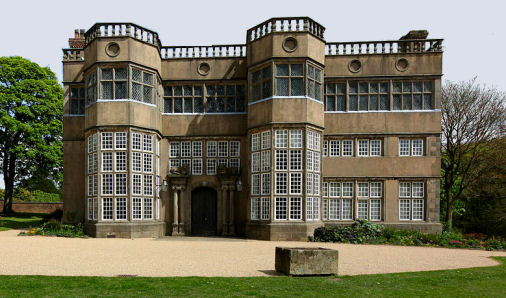Astley Hall
OS Grid Ref:- SD 574 183
 Astley Hall at Chorley is a museum and art gallery housed in a Grade I listed country house. The Hall is set in the grounds of Astley Park which includes woodland, a lake, a fully renovated Victorian walled garden.
Astley Hall at Chorley is a museum and art gallery housed in a Grade I listed country house. The Hall is set in the grounds of Astley Park which includes woodland, a lake, a fully renovated Victorian walled garden.
Famous visitors to the hall include Oliver Cromwell, who is said to have stayed at Astley Hall during the Battle of Preston in the seventeenth century and reportedly left his boots behind. The boots remain, as do doubts that they actually belonged to Cromwell.
Astley Hall is really three houses in one, at its core of the house is a Tudor H-plan manor, around 1575 the manor was rebuilt in typical Elizabethan style as a courtyard mansion. The house was once more rebuilt in 1666 in Renaissance style.
The site was acquired from the Knights of St. John of Jerusalem by the Charnock family in the fifteenth century. The Charnocks built the original timber-framed house, around a small courtyard, about 1575-1600. In 1665, Margaret Charnocke married Richard Brooke of Mere in Cheshire and the couple built the present grand but asymmetrical front range of brick with a pair of vast mullion and transomed bay windows. This front has a doorway with Ionic columns. The Brookes family became extinct in the male line and the house descended to Robert Townley Parker of Cuerden, who added the south wing in 1825 and stuccoed the exterior, probably to the design of Lewis Wyatt, who worked for him at Cuerden Hall. In 1922 the house and its contents were given to Chorley Corporation by Reginald Tatton, as a memorial to the local men killed in World War I. It has since been maintained as a museum.
The interior boasts stunning ornate plasterwork in the ceilings of the Great Hall and drawing room, which dates from the seventeenth century and is generally acknowledged as some of the finest in Britain. The staircase dates from the same period and has a carved acanthus scroll balustrade and square newels topped with vases of flowers.
The lower parts of the hall are panelled with inset paintings of a curious selection of portraits, including Protestants such as Elizabeth I and William the Silent; Catholics such as Philip II and Ambrogio Spinola; the explorers Christopher Columbus and Ferdinand Magellan, and Muhammadans such as Bajazet and Mohammed II, Sultans of Turkey.
The whole width of the house on the top storey is occupied by a long gallery which contains the finest shovelboard table in existence, which measures 23˝ feet in length. A recent discovery at Astley is a seventeenth century Priest Hole beside the fireplace in the first floor Stucco Room.
Astley Hall also contains fine oak furniture, Flemish tapestries and wooden panelling. The east facing part of the walled garden is home to a community food growing project and includes a small orchard alongside raised beds full of vegetables, fruits, herbs and salads. Much of the produce is used by Café Ambio, the onsite café within the Coach House building.
The grounds with a small lake were landscaped by John Webb and feature a stream which meanders through a wooded ravine.
Directions
Astley Hall is a 15 minute drive from junction 27 of the M6, follow the A49 Preston route until you see the brown signs at the village of Euxton. Parking for cars and coaches is available in the Astley Village car park to the rear of Astley Hall. This is approximately 300m from the front of the hall. There is no charge for parking.
